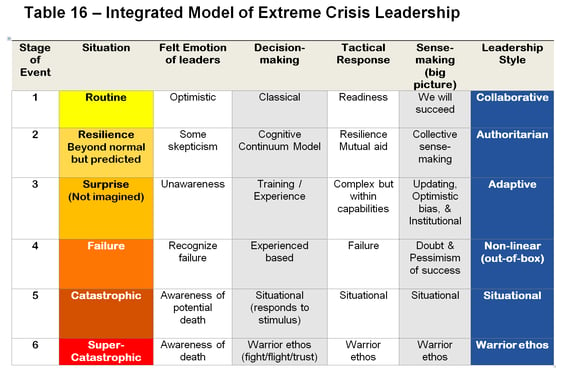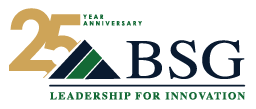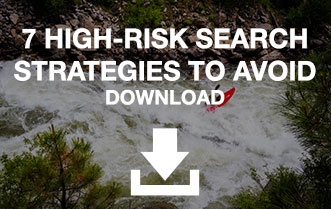How did I spend my Sunday morning? Differently than most routine Sundays. While each Sunday I try to spend in “reading & learning mode”—scanning business research, business school publications, and strategy consulting firm white papers for new ideas we can share through with our clients & executives—this Sunday was much more narrowly focused: I was looking for the best research & thinking about “leadership in times of crisis.” As we as a firm at BSG focus on finding new leaders for middle market growth equity businesses, I wanted to find the latest on how to best lead in a crisis. I had many motivations driving this search—sharing it with all leaders of all types from our client’s business leaders, to community leaders, to family leaders... how should we all best react and respond in the face of crisis? And what counter-intuitive behaviors and thinking processes are best suited for what types of such crises? The best and most comprehensive analysis I found for crisis leadership came from a 300+ page PhD Dissertation & capstone project written a few years back by a business school student at Kennesaw State University in Georgia.
[Note: If you’re an impatient reader, jump to the last paragraph in bold/italics for my conclusion]
March 25, 2020, BSG Note: Clark sat with Dr. Casto in an interview on crisis leadership. View the entire interview here.
ANALYSIS: As I feared, it turns out there is no simple cookbook with one recipe for all crises. As I learned, there’s a crisis continuum, beginning at “Routine crisis,” and escalating through “Surprise,” “Failure,” “Catastrophic,” ending in “Super-Catastrophic.” And each crisis level & type engenders a different set of emotions, decision-making style, crisis response, sensemaking, and ultimately leadership approach. At which crisis stage do we find ourselves currently in the U.S. just after Covid-19 was declared a global pandemic as the Corona Virus metastasized from East to West without any perceived abatement?
It appears from the table below (Charles A. Casto’s 2014 PhD thesis on Crisis Management and Extreme Event Leadership) that we are well beyond the first 2 stages of the 6 defined escalating crisis types — Routine or Resilience stages. And that we may have blown through the next 2 stages of Surprise and Failure. Note that crisis stage 3 called “Surprise crisis” has a dangerous analytical human response, referred to in the “sense-making” column as “optimistic bias.” This is where a crisis is effectively under-estimated, and the optimistic bias drives a slower, weaker, or less uniform response to a crisis than is truly warranted. The fourth crisis stage is referred to as the “Failure” stage. This is where the avoidance of an escalation in the crisis doesn’t occur, and mitigation is the next driving goal of crisis leadership. We hear “containment” as a word used a lot that may be similar in today’s crisis circumstance we’re facing with C-19. Note that the crisis leadership style required at Stage 4 is “non-linear.” Linear thinking would be defeated by the innate geometric compounding factors of a Stage 4 level crisis.
In Stage 5 and 6, referred to by Casto as Catastrophic and Super-Catastrophic, we enter a crisis leadership modality that becomes essentially completely situational. Meaning there IS no leadership recipe for these stages. Each is unique unto themselves.
Worthy of note however is what appears to be unique only to Stage 6– what’s referred to as leadership that has been referred to as the “Warrior ethos.” There has been much written about warrior ethos leadership, chronicled as far back as 500 BC in Sparta and Ancient Greece, all the way to modern times, where most often it is used to partially define our U.S. military code of conduct. In pure military context, it puts “mission first” over troops. In civilian context, it puts “workers over mission.” For more on warrior ethos leadership, see https://threeminuteleadership.com/2017/08/20/the-warrior-ethos/. Also popularized by the book by Steven Pressfield, link below.
While Casto’s research spans more than 300 pages, the most important conclusions from his research are found between the pages 263-270 (306 pages in total).
Starting off that section, here is the first paragraph—
“In the case of the catastrophic and super-catastrophic events, felt emotions are at their peak and dominate a leader‘s thoughts. Under these dangerous contexts, situational leadership concepts begin to influence the leader‘s decision-making. Situational leadership concepts in the dangerous categories of extreme events can include: instinct, intuition, hopelessness, defiance and at the far end of the leadership continuum, warrior ethos.”
If indeed we may find ourselves at Crisis Stage 5 or 6 of Catastrophic or Super-Catastrophic, what became clear to me was that the warrior ethos could be something every one of us could embody and didn’t require a supreme leader in government, religion or military to alone bear the burden—leading with selflessness in the warrior ethos can simply be demonstrated by all of us in taking a “for the good of the whole” versus “for my own good” approach. That could be by making the decision to self-quarantine, restrain the urge to hoard for oneself in favor of sharing with others, and perhaps even “paying it forward” to those who are as or more economically in harm’s way as perhaps physically. What does this last warrior ethos behavior look like? If you feel it prudent for the good of the whole to cancel a service or activity to preserve your “social distancing perimeters,” think about paying that service provider anyway. Even if you don’t receive the benefits of service.

For the complete paper (with no paywall), see https://digitalcommons.kennesaw.edu/cgi/viewcontent.cgi?article=1608&context=etd
4-15-2014: Crisis Management: A Qualitative Study of Extreme Event Leadership. Charles A. Casto. Kennesaw State University, Coles College of Business. Thesis for PhD in Business Administration
For More on the Warrior Ethos, see Steven Pressfield’s book, https://play.google.com/store/books/details/Steven_Pressfield_The_Warrior_Ethos?id=OSXjAAAAQBAJ&hl=en-US&gl=us




